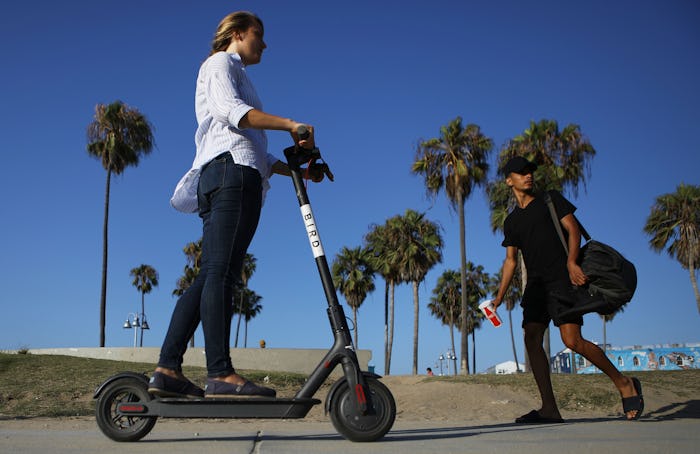Life

Electric Scooters Are Turning Out To Be Pretty Dangerous, As It Turns Out
Electric scooters are quickly making their way across the United States. Some cities are even considering incorporating them into ride share programs. It all seems cool, but new technology always comes with some type of risk. Perhaps unsurprisingly, a new study found that electric scooters are sending people to the emergency room (like, more people than you thought). They may help speed up travel, but it's clear there are still a lot of kinks to be worked out when it comes to this form of transportation.
Scooters used to just be a thing kids liked to zip around on, but recently the electric variety has been eyed as a solution to urban transportation issues, as Vox reported. In September 2017, Bird, Inc. kickstarted the trend in Santa Monica by dropping thousands of the electric-powered scooters throughout the city, according to Forbes. They're dock-free, which means users can drop the scooters off anywhere, as long as they aren't obstructing traffic; riders pay to use the standing scooters by the minute. There's no question that the scooters have become popular since. As the Bird website states, the scooters now operate in over 100 cities with 10 million rides to date. (Similar electric scooter companies also exist, such as Skip and dock-free Lime.)
Unfortunately, any new form of transportation comes with its safety concerns. A study recently published in JAMA Network Opens examined medical records from two Southern California emergency departments in order to better understand electric scooters and injuries.
Using data from University of California, Los Angeles-affiliated hospital emergency departments, researchers looked at accidents associated with standup electric scooters over one year. As the study's abstract explained, a total of 249 patients went to the emergency departments with injuries from electric scooters in 12 months. Of those 249 patients, 228 were injured as riders and 21 as non-riders.
Researchers reported that 10.8 percent of riders were younger than 18 years of age. This isn't surprising, because some minors are allowed to use electric scooters. Under California law, scooter riders have to be at least 16 and additionally have a driver's license of permit. However, according to a September 2018 Curbed article, companies in Los Angeles have an even stricter age requirement of 18 years old.
The injuries that people sustained varied. The most common injuries were fractures, head injuries, and soft-tissue injuries, according to HelathDay, although 15 patients were admitted to the hospital, including two with severe head injuries.
Researchers did find one concerning trend among riders: they aren't wearing helmets. According to the study's abstract, only 4.4 percent of riders were documented to be wearing a helmet.
That is a big deal! Electric scooters may not get up to super high speeds, maxing out at about 15 miles per hour, but you still need protection. One issue is that these ride share programs don't currently offer helmets.
Although regular scooter riders should carry their own helmet, Dr. Frederick Rivara, a professor of pediatrics, pointed out that "... cities that allow these things ought to partner with the companies to try to solve the problem of how to provide helmets for the riders — with these things being motorized, there's a real need to address this problem."
"Riders of electric scooters share roads with fast-moving vehicular traffic and share sidewalks with lots of pedestrian traffic and uneven curbs, and riders seem to underestimate hazards," senior study author Dr. Joann Elmore, professor at UCLA's David Geffen School of Medicine, told HealthDay.
So be aware of your local traffic laws and always remember to wear a helmet... whether you're riding a scooter, a bike, or anything else with wheels and no roof.